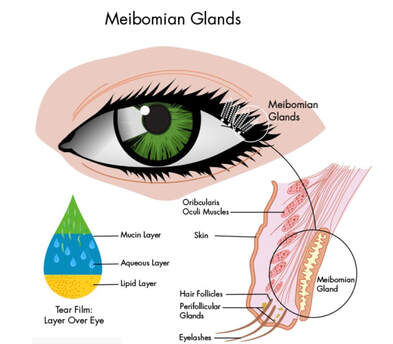
Dry eyes are one of the most common eye diseases we treat at Sedona Eye Care. Arizona's high desert low humidity environment intensifies the drying that occurs with aging, contact lenses wear, certain medications, auto immune disease, diet, computer and smart device screen use. Dry eyes can result in scratchy, itching, burning, stinging, gritty, foreign body sensation, tired eyes, light sensitivity, difficultly opening eyes on awakening, mucus discharge and tearing. Another common symptom is fluctuating vision and blurred vision.
Dry Eye” has been the term generally applied to a variety of uncomfortable eye surface problems, much in the same way the term back pain is generally used. The eye feels uncomfortable, but the cause is unknown. Dry eye symptoms have primarily been thought to be a direct result of the eye’s inability to produce the proper amount of natural tears, but we now know that is not the case for many dry eye sufferers. Today, the leading cause of dry eye is known to be Meibomian Gland Disease (MGD) for over 80% of patients who present with symptoms. These tiny oil glands which line the margin of the eyelids, secrete oil to coat the eye’s surface and keep the water component of our tears from evaporating. The tear film lubricates and keeps the surface of our eyes healthy.
At Sedona Eye Care, we are able to photograph your Meibomian (oil) glands with the Meibox infrared photographic system. These photos not only allow us to diagnose the health of the meibomian glands but to demonstrate the condition of the meibomian glands to our patients. This may be used to help design a treatment plan for your dry eye disease.
Most eye doctors simply treat your dry eyes with eyedrops. Here at Sedona Eye Care, our doctors do so much more. With an integrative approach, the expertise, the experience, the high-tech instruments for diagnosis and treatment; they design a specialized treatment plan just for you. Dr. Wright and Dr. Ivy have created a cutting-edge dry eye relief clinic to treat even the most severe dry eye cases prescribing medications, naturopathic and homeopathic supplements and home remedies; as well as new treatments such as iLux. Many patients stated that the iLux treatment is a spa like experience for the eyes. The Ilux devise is used to express patient’s meibomian glands, providing gentle heat and compression to clear blockages and keep them functioning as they should. This both treats MGD and prevents it from getting worse – keeping eyes healthy and preventing the disease from progressing.
|
|
Click the video on the left for information on the Systane iLux Treatment System technology for dry eye treatment. |
Regardless of the cause of your dry eyes, Doctors Wright and Ivy are experienced at finding solutions to get you back to enjoying your vision clearly and comfortably. Many patients that had given up on treating their dry eye disease have found relief at our eye center. There is no panacea or silver bullet to treat dry eye as it is a multifaceted disease. The doctors at Sedona Eye Care can determine what combination of therapies you will need to treat your dry your dry eye.
There are different forms of dry eye. Over 80% of dry eye is caused by Meibomian gland dysfunction (MGD).Depending on the type of dry eye you have, there are different treatments available.
Some of the treatments that are used to treat dry eye include:
· Over-the-counter eye drops/lubricants
· Hot compresses
· Lid hygiene
· Prescription eye drops (Restasis, Xiidra)
· Prescription oral antibiotics
· Punctal plugs
· Moisture chamber goggles
· Blinking exercises
· Omega 3 supplements
· Meibomian gland expression
· iLux for MGD, iLux is the latest treatment for MGD and more effective as the degree and duration of compression can be applied on different areas of the lids. This newer versatile treatment is about one half the cost of Lipiflow.
· Epstein lid Debrider to remove keratin from the meibomian gland orifices
· Lid pro for blepharitis plaque, collarette and debris removal
· Amniotic membranes, in moderate to severe dry eye, this thin layer of tissue is applied to the cornea under a bandage contact lense. This tissue gradual dissolves in place and promotes healing by releasing anti-inflammatory, human growth hormone and antimicrobials to the surface of the eye.
There are different forms of dry eye. Over 80% of dry eye is caused by Meibomian gland dysfunction (MGD).Depending on the type of dry eye you have, there are different treatments available.
Some of the treatments that are used to treat dry eye include:
· Over-the-counter eye drops/lubricants
· Hot compresses
· Lid hygiene
· Prescription eye drops (Restasis, Xiidra)
· Prescription oral antibiotics
· Punctal plugs
· Moisture chamber goggles
· Blinking exercises
· Omega 3 supplements
· Meibomian gland expression
· iLux for MGD, iLux is the latest treatment for MGD and more effective as the degree and duration of compression can be applied on different areas of the lids. This newer versatile treatment is about one half the cost of Lipiflow.
· Epstein lid Debrider to remove keratin from the meibomian gland orifices
· Lid pro for blepharitis plaque, collarette and debris removal
· Amniotic membranes, in moderate to severe dry eye, this thin layer of tissue is applied to the cornea under a bandage contact lense. This tissue gradual dissolves in place and promotes healing by releasing anti-inflammatory, human growth hormone and antimicrobials to the surface of the eye.